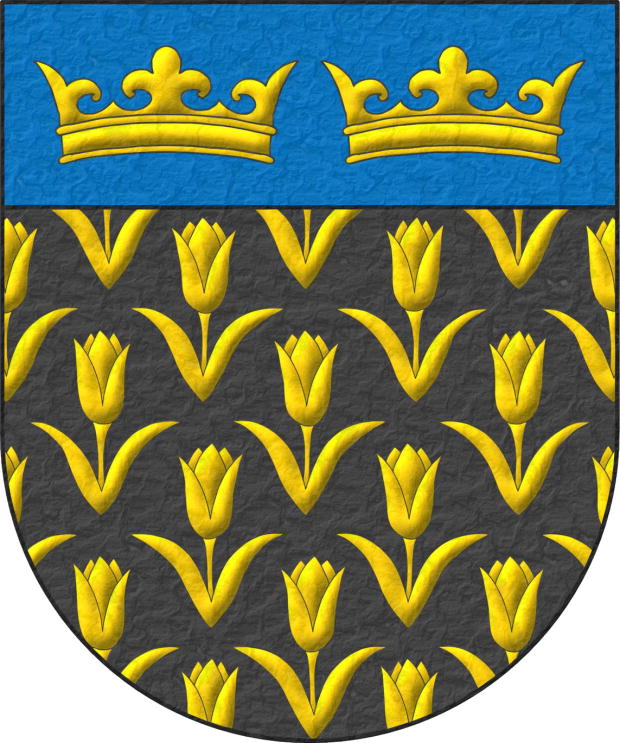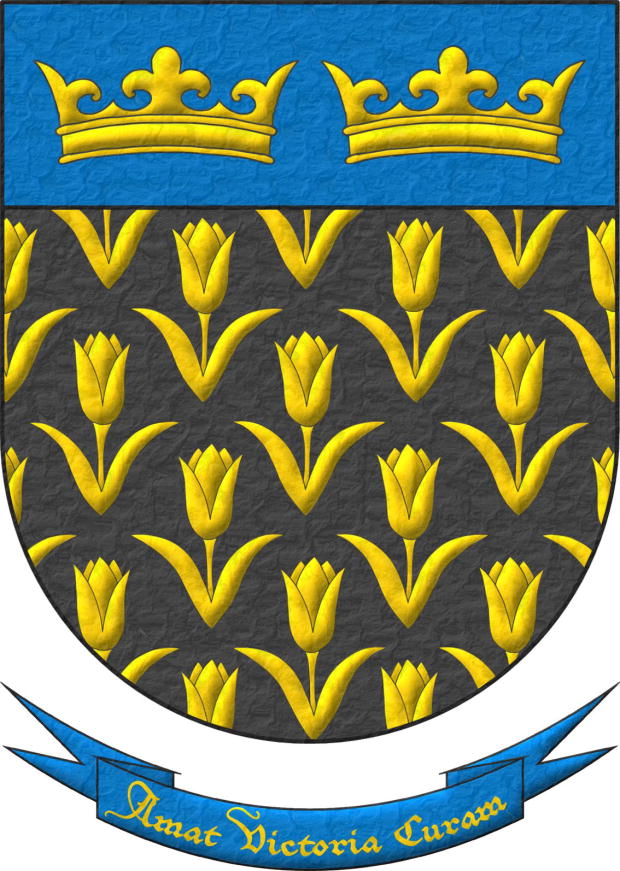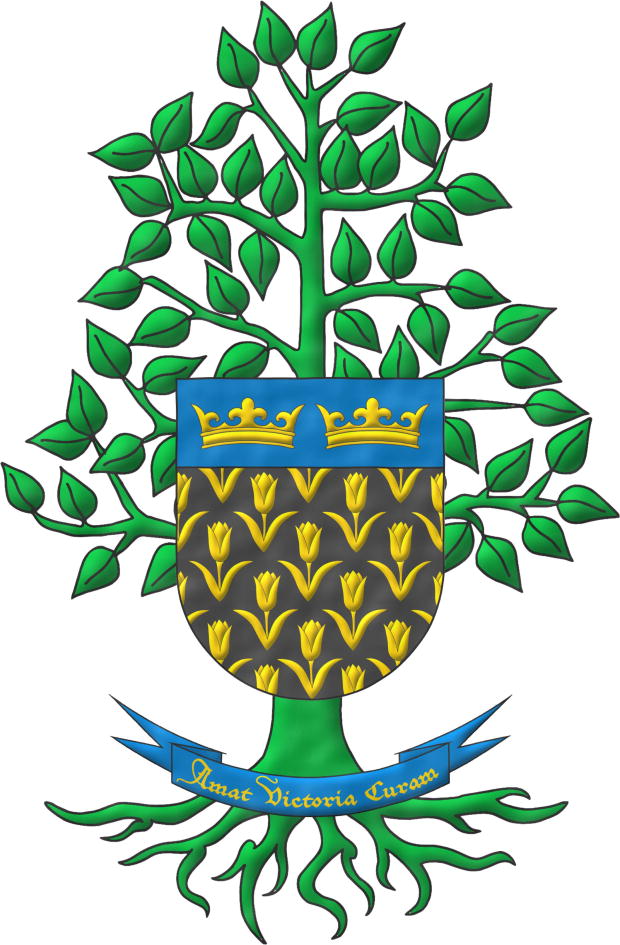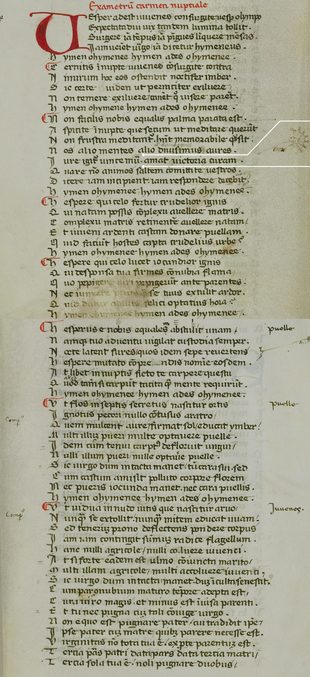
Bartolomé Quesada Valles

Sable, semé of Tulips Or; on a chief cousu Azure, two Crowns Or, in fess.
Escudo de sable, sembrado de tulipanes de oro; el jefe cosido de azur, dos coronas de oro, en faja.
Blazon keywords: Without divisions, Sable, Or, Azure, Chief, Two, Crown, In fess, Semé and Tulip.
Style keywords: Soft metal, Semi-circular, Illuminated, Outlined in the field tincture, Outlined in sable and Cousu.
Classification: Coat of arms, Created and Personal.
Bearer: Quesada Valles, Bartolomé.


Amat victoria curam

Sable, semé of Tulips Or; on a chief cousu Azure, two Crowns Or, in fess. Motto «Amat victoria curam».
Escudo de sable, sembrado de tulipanes de oro; el jefe cosido de azur, dos coronas de oro, en faja. Lema «Amat victoria curam» de oro, sobre una filacteria de azur.
Blazon keywords: Without divisions, Sable, Or, Azure, Chief, Two, Crown, In fess, Semé, Tulip, Motto and Scroll.
Style keywords: Soft metal, Semi-circular, Illuminated, Outlined in the field tincture, Outlined in sable and Cousu.
Classification: Coat of arms, Created and Personal.
Bearer: Quesada Valles, Bartolomé.


B. Quesada, coat of arms with motto and support

Sable, semé of Tulips Or; on a chief cousu Azure, two Crowns Or, in fess. Supporter A Tree Vert, eradicated. Motto «Amat victoria curam».
Escudo de sable, sembrado de tulipanes de oro; el jefe cosido de azur, dos coronas de oro, en faja. Por sostén un árbol de sinople, arrancado. Lema «Amat victoria curam» de oro, sobre una filacteria de azur.
The original design of this coat of arms, along with many others heraldic devices, is registered in [Salmerón Cabañas, A.; 2015a; page 11].
Blazon keywords: Without divisions, Sable, Or, Azure, Chief, Two, Crown, In fess, Semé, Tulip, Crest and mantling, Vert, Tree, Erased, Supporter (thing), Supporter, Motto and Scroll.
Style keywords: Watercolor, Semi-circular, Illuminated, Outlined in the field tincture, Outlined in sable and Cousu.
Classification: Coat of arms, Created and Personal.
Bearer: Quesada Valles, Bartolomé.


B. Quesada, video of the blazon
This video shows the ideation of this coat of arms step by step, its field, chief cousu, figures, motto and it supporter. The music is «Sonata No. 8 in G major 1. Allegro» of Ludwig van Beethoven interpreted by Paul Rosenthal, violin, and Edward Auer, piano, available under an «Open Audio License».
Credits:
- Paul Rosenthal violin performance.
- Edward Auer piano performance.
Blazon keywords: Without divisions, Sable, Or, Azure, Chief, Two, Crown, In fess, Semé, Tulip, Vert, Tree, Erased, Supporter (thing), Supporter, Motto and Scroll.
Style keywords: Semi-circular, Illuminated, Outlined in the field tincture, Outlined in sable and Cousu.
Classification: Video, Created and Personal.
Bearer: Quesada Valles, Bartolomé.

![Ver [Alonso Gamo, J. M.; 2004] en referencias bibliográficas. Libro abierto, hojas de plata, filo de oro, guardas de gules, tapas de sable.](../css/Libro.Bibliografia.png)
Alonso Gamo, J. M.; 2004
José María Alonso Gamo, «Cayo Valerio Catulo: Poesías Completas», Volume I Complete Works of Alonso Gamo, edited by AACHE Ediciones de Guadalajara, 385 pages, ISBN 84-96236-15-3, Legal Deposit GU. 202/2004, Guadalajara, 2004.
The initial pages explain the author's devotion to Catullus and present the complete works of José María Alonso Gamo. From page 15 to 134, it studies Catullus and his poetic work. From page 137 to 335, it presents his poems in Latin and their translation by José María Alonso Gamo. From page 337 to 382, the bibliography on Catullus. This publication is made 10 years after the death of José María Alonso Gamo in 1993, by his express wish.
Bibliographical reference of century XXI.
The author is Alonso Gamo, José María.
Bibliographical reference mentioned in the following article:
External links:


![Ver [Catullus, C. V.; Century I B.C.] en referencias bibliográficas. Libro abierto, hojas de plata, filo de oro, guardas de gules, tapas de sable.](../css/Libro.Bibliografia.png)
Catullus, C. V.; Century I B.C.

Gaius Valerius Catullus, from 87 to 57 BC or from 87 to 54 BC, «Corpus Catuliano, 116 Poems: Poem number 62, Wedding Hymn in Hexameters», Rome, 1st Century BC.
Gaius Valerius Catullus, Poem LVII, beginning
Vesper adest, iuvenes, consurgite: Vesper Olympo
Exspectata diu vix tandem lumina tollit.
Surgere iam tempus, iam pinguis linquere mensas,
Iam veniet virgo, iam dicetur Hymenaeus.
Hymen o Hymenaee, Hymen ades o Hymenaee!
Cernitis, innuptae, iuvenes? consurgite contra:
Nimirum Oetaeos ostendit Noctifer ignes.
Sic certest; viden ut perniciter exsiluere?
Non temere exsiluere, canent quod vincere par est.
Hymen o Hymenaee, Hymen ades o Hymenaee!
Non facilis nobis, aequales, palma parata est:
Aspicite, innuptae secum ut meditata requirunt.
Non frustra meditantur: habent memorabile quod sit.
Nec mirum, penitus quae tota mente laborant.
Nos alio mentes, alio divisimus aures:
Iure igitur vincemur: amat victoria curam.
Quare nunc animos saltem convertite vestros;
Dicere iam incipient, iam respondere decebit.
Hymen o Hymenaee, Hymen ades o Hymenaee!
...
My translation in hendecasyllables
...
They note everything worth remembering and do not practice in vain,
let it not surprise us, for their minds are focused on the work.
But if we distract our ears and scatter our thoughts,
by law they will defeat us, for victory loves those who care.
...
The complete poem can be consulted in Latin and Spanish in [Alonso Gamo, J. M.; 2004; page 242] and in Latin in [Gaio da Legnago, A. del; 1375; reverse of folio 17].
Bibliographical reference of century I B.C.
The author is Catullus, Gaius Valerius.
The following article cites this bibliographic reference:
External links:
- The text of Catullus in ASCII was extracted from.
- The edition and punctuation follow that of Google Books.
- Catullus Online: Poems.
- Catullus Online: Edited pages.


![Ver [Gaio da Legnago, A. del; 1375] en referencias bibliográficas. Libro abierto, hojas de plata, filo de oro, guardas de gules, tapas de sable.](../css/Libro.Bibliografia.png)
Gaio da Legnago, A. del; 1375

Antonio del Gaio da Legnago, «Catulli Veronensis Liber Incipit, Manuscript», Deposited in Paris at the National Library of France, Parisinus lat. 14137. Available in digital version at «http://CatullusOnline.org» edited by Dániel Kiss. Verona, 1375.
Manuscript made in Italian Gothic minuscule, usually called «rotunda». The identification of Antonio del Gaio da Legnago as the scribe was made by Giuseppe Billanovich. On parchment, initial folio plus 36 double-sided folios (72 pages) measuring 24.0 x 16.5 centimeters, with a written area of 16.0 x 10.5 centimeters. Antonio del Gaio da Legnago left the manuscript incomplete, which was finished by a second hand that also made numerous corrections.
The recto of folio 1 begins with the phrase «Catulli Veronensis liber incipit» and ends with a shield of azure with nine gold figures, four, two, two, one, with the 5th, 6th, and 9th in the tip being pear-shaped and the others more oval, which I do not identify although they could be stones or islands. On the recto of folio 36 appears the date 1375.
Catullus's poem 62 is found between the verso of folio 17 and the recto of folio 18, along with the phrase «amat victoria curam».
Verse 14 is missing
On the verso of folio 17, «amat victoria curam» is found in line 15 of the poem and not in line 16 because Antonio del Gaio da Legnago seems to have completely skipped verse 14 «Nec mirum, penitus quae tota mente laborant». I have always thought that the absence of this verse could help establish a possible path of manuscript copies of Catullus's poetry.Hand pointing at the motto
An interesting detail is that on this verso of folio 17, there is a painting of what in heraldry is known as a «gloved hand». It was painted later, and it points with its index finger directly at the phrase «amat victoria curam».Bibliographical reference of century XIV.
The author is Gaio da Legnago, Antonio del.
The following article cites this bibliographic reference:
External link:


![Ver [Kleisner, T.; 2009] en referencias bibliográficas. Libro abierto, hojas de plata, filo de oro, guardas de gules, tapas de sable.](../css/Libro.Bibliografia.png)
Kleisner, T.; 2009
Tomá Kleisner, «Amat Victoria Curam: The Device of Archduke Matthias on his Medals», Studia Rudolphina, issue 9, pages 87-99, bulletin of the Research Center for Visual Arts and Culture in the Age of Rudolf II (Research Center for Graphic Arts and Culture in the Age of Rudolf II, founded in January 2000), from the Institute of Art History, Academy of Sciences of the Czech Republic. edited by Lubomír Konecný and Beket Bukovinská, published by Artefactum, ISBN 978-80-86890-27-2, ISSN 1213-5372, Prague, 2009.
The article reviews the use of the motto «Amat victoria curam» by Archduke Matthias on his medals and coats of arms, which he used as early as 1579, at the age of 22.
Regarding the origin of the motto «Amat victoria curam», Tomá Kleisner refers us to the verses of [Catullus, C. V.; Century I B.C.; poem LVII, verse 16].
Bibliographical reference of century XXI.
The author is Kleisner, Tomá.
External resources:
Internal resources: KleisnerT2009.AmatVictoriaCuram.Original.pdf original and KleisnerT2009.AmatVictoriaCuram.Resumen.pdf summary.

Continue with: ANPC.
-
Language
-
Categories of heraldry
-
Divisions of the field
- Without divisions
- Party per pale
- Party per fess
- Party per bend
- Party per bend sinister
- Tierce
- Tierce sinister
- Tierced per pale
- Tierced per fess
- Tierced per bend
- Tierced pallwise inverted
- Quarterly
- Quarterly per saltire
- Gyronny
- Party per fess, the chief per pale
- Party per pale, the sinister per fess
- Party per fess, the base per pale
- Party per pale, the dexter per fess
- Chapé
- Chaussé
- Embrassé
- Contre-embrassé
- Party per chevron
- Enté
- Enté en point
- Flanched
-
Metals
-
Colours
-
Furs
-
Other tinctures
-
Ordinaries and sub-ordinaries
-
Diminutives of the ordinaries
-
Geometric charges
-
Composite ordinaries
-
Inanimate charges from Nature
Atom, Crescent, Diamond, Emerald, Estoile, Increscent, Lightning flash, Moon, Mount, Mullet, Mullet of four points, Orbital, Plough of Ursa Major, Rainbow, Ray of the sun, River, Sea, Snowflake, Sun, Sun in splendour, Sun of May, Trimount, Water and Wave.
-
Vegetal charges from Nature
Acorn, Apple, Apple tree, Ash, Bluebonnet, Camellia, Chrysanthemum, Cinquefoil, Cornflower, Dogwood flower, Double rose, Elm, Fleur de lis, Flower, Gourd, Holm oak, Hop cone, Kapok tree, Laurel, Lily, Linden, Lotus flower, Madonna lily, Mexican cedar tree, Oak, Olive tree, Palm tree, Plantain plant, Pomegranate, Poplar leaf, Rose, Shamrock, Sunflower, Thistle, Tree, Tulip, Vine and Wheat.
-
Animal charges from Nature
Badger, Bald eagle, Barbel, Barn owl, Bear, Beaver, Beetle, Bighorn sheep, Blackbird, Boar, Brach hound, Bull, Doe, Dog, Dolphin, Dove, Eagle, Elephant, Falcon, Female figure, Fish, Flame, Fly, Fox, Frog, Goat, Goldfinch, Goose, Heron, Horse, Hummingbird, Jaguar, Lark, Leopard, Lion, Lion passant, Lion rampant guardant, Lioness, Lynx, Male figure, Martlet, Merino ram, Owl, Panther, Parrot, Peacock, Pelican, Pelican in her piety, Puffin, Quetzal, Raven, Roe deer, Rooster, Savage, Seagull, Serpent, She-wolf, Stag, Starling, Talbot, Tyger, Vulture, Warren hound and Wolf.
-
Parts of natural charges
Arm, Beak, Branch, Caboshed, Chest, Claw, Covert, Dorsal fin, Eagle claw, Ermine spot, Escallop, Feather, Foot (palmiped), Foreleg, Forepaw, Hand, Head, Heart, Hoof, Leaf, Neck, Ostrich feather, Palm frond, Paw, Roe deers' attires, Shoulder, Sprig, Stags' attires, Stem, Swallow-tail, Tail, Tail addorsed, Tail fin, Talon, Tooth, Trunk, Trunk (elephant), Two hands clasped, Two wings in vol, Udder, Wheat spike, Wing and Wrist.
-
Artificial charges
Ace of spades, Anchor, Anvil, Arch, Arm vambraced, Armillary sphere, Arrow, Axe, Bell, Bell tower, Beret, Bonfire, Book, Bookmark, Bow, Branding iron, Bridge, Broken, Buckle, Cannon, Cannon dismounted, Cannon port, Canopy roof, Carbuncle, Castle, Celtic Trinity knot, Chain, Chess rooks, Church, Clarion, Clay pot, Closed book, Club, Column, Comb, Compass rose, Conductor's baton, Cord, Covered cup, Crozier, Crucible, Cuffed, Cup, Cyclamor, Dagger, Double vajra, Drum, Ecclesiastical cap, Fanon, Federschwert, Fleam, Four crescents joined millsailwise, Galician granary, Garb, Gauntlet, Geometric solid, Grenade, Halberd, Hammer, Harp, Host, Hourglass, Key, Key ward, Knight, Knot, Lantern, Letter, Line, Loincloth, Menorah, Millrind, Millstone, Millwheel, Monstrance, Mortar, Mullet of six points pierced, Nail, Non-classic artifact, Norman ship, Number, Oar, Oil lamp, Open book, Page, Pair of scales, Parchment, Pestle, Piano, Pilgrim's staff, Plough share, Polish winged hussar, Port, Portcullis, Potent, Quill, Ribbon, Rosette of acanthus leaves, Sabre, Sackbut, Sail, Scroll, Scythe, Sheaf of tobacco, Ship, Skirt, Spear, Spear's head, Stairway, Star of David, Step, Sword, Symbol, Tetrahedron, Torch, Tower, Trident, Trumpet, Turret, Two-handed sword, Wagon-wheel, Water-bouget, Wheel, Winnowing fan and With a turret.
-
Immaterial charges
Angel, Archangel, Basilisk, Dragon, Dragon's head, Garuda, Golden fleece, Griffin, Heart enflamed, Justice, Mermaid, Our Lady of Mercy, Ouroboros, Paschal lamb, Pegasus, Phoenix, Sacred Heart of Jesus, Saint George, Sea-griffin, Trinity, Triton, Unicorn, Winged hand and Wyvern.
-
External elements
-
Heraldic creations
-
References
-
Formats
-
Keywords on this page
ANPC, Watercolor, Point upwards, Erased, Azure, Pair of scales, Bibliography, Crown, Cousu, Created, Outlined in sable, Outlined in the field tincture, Dexter, Two, In fess, Coat of arms, Sword, Female figure, Scroll, Personal, Hilted, Gules, Illuminated, Chief, Justice, Motto, Semi-circular, Soft metal, Or, Argent, Without divisions, Quesada Valles, Bartolomé, Sable, Semé, Century I B.C., Century XIV, Century XXI, Sinister, Vert, Socioeconomic, Supporter, Supporter (thing), Crest and mantling, Tulip, One, Vested, Video and Tree.
